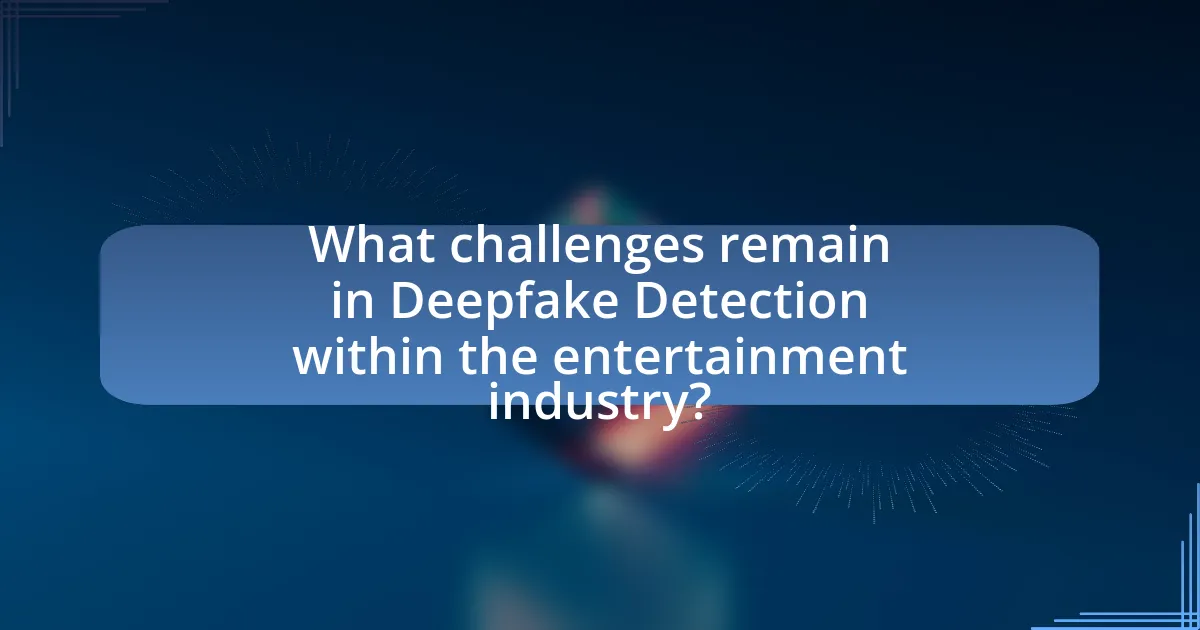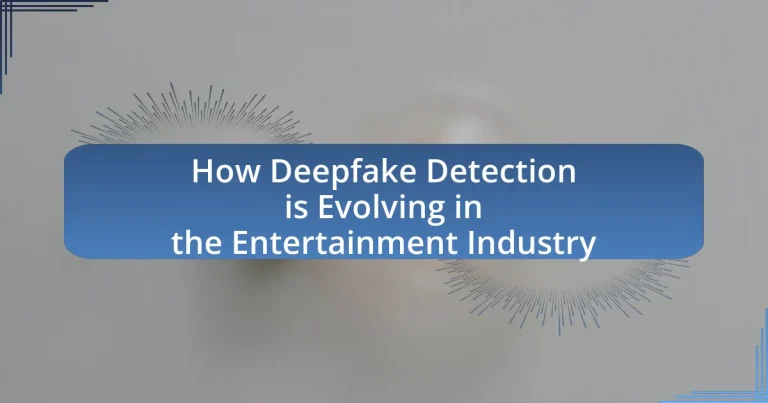Deepfake detection in the entertainment industry involves the use of advanced technologies and machine learning algorithms to identify manipulated audio and visual content created through artificial intelligence. This detection is essential for maintaining media integrity, as deepfakes can mislead audiences and damage reputations. The article explores how detection methods work, the technologies employed, and the importance of these systems in combating misinformation. It also discusses the evolving nature of deepfake technology, the challenges faced by detection systems, and the ethical dilemmas arising from deepfake usage, highlighting the need for continuous advancements and industry collaboration to safeguard authenticity in entertainment.

What is Deepfake Detection in the Entertainment Industry?
Deepfake detection in the entertainment industry refers to the technological processes and methods used to identify manipulated media that employs artificial intelligence to create realistic but fabricated audio and visual content. This detection is crucial as deepfakes can undermine trust in media, mislead audiences, and damage reputations. The entertainment industry faces significant challenges from deepfakes, prompting the development of advanced detection tools that utilize machine learning algorithms to analyze inconsistencies in video and audio data, such as unnatural facial movements or mismatched audio-visual synchronization. Research indicates that as deepfake technology evolves, so too must detection methods, with studies showing that deepfake detection systems can achieve accuracy rates exceeding 90% when trained on diverse datasets.
How does Deepfake Detection work in the context of entertainment?
Deepfake detection in the context of entertainment works by utilizing advanced algorithms and machine learning techniques to identify manipulated media. These detection systems analyze various features of videos and images, such as inconsistencies in facial movements, unnatural lighting, and audio mismatches, which are often present in deepfakes. For instance, research published in 2020 by the University of California, Berkeley, demonstrated that deepfake detection models could achieve over 90% accuracy by examining pixel-level discrepancies and temporal inconsistencies in video frames. This technological approach is crucial for maintaining authenticity in entertainment, as it helps combat misinformation and protects the integrity of actors’ performances.
What technologies are used in Deepfake Detection?
Deepfake detection utilizes several advanced technologies, including machine learning algorithms, neural networks, and digital forensics techniques. Machine learning algorithms analyze patterns in video and audio data to identify inconsistencies that may indicate manipulation. Neural networks, particularly convolutional neural networks (CNNs), are trained on large datasets of authentic and deepfake content to improve detection accuracy. Digital forensics techniques examine metadata and pixel-level anomalies to uncover signs of tampering. These technologies collectively enhance the ability to differentiate between genuine and altered media, as evidenced by studies demonstrating their effectiveness in identifying deepfakes with high precision.
How do these technologies identify manipulated content?
Technologies identify manipulated content through advanced algorithms that analyze inconsistencies in visual and audio data. These algorithms utilize machine learning techniques to detect anomalies such as unnatural facial movements, mismatched lip-syncing, and irregular lighting conditions that deviate from authentic content. For instance, deep learning models trained on large datasets of genuine and altered media can recognize subtle differences that human observers might miss. Research has shown that these detection systems can achieve high accuracy rates, with some models reporting over 90% effectiveness in identifying deepfakes, as evidenced by studies published in journals like IEEE Transactions on Information Forensics and Security.
Why is Deepfake Detection important for the entertainment industry?
Deepfake detection is crucial for the entertainment industry because it protects the integrity of content and prevents the misuse of digital media. The rise of deepfake technology poses significant risks, including the potential for misinformation, defamation, and unauthorized use of an individual’s likeness. For instance, a study by the DeepTrust Alliance found that 96% of deepfakes are used for malicious purposes, which can severely damage reputations and undermine trust in media. Furthermore, the entertainment industry relies heavily on the authenticity of performances and storytelling; thus, effective detection methods are essential to maintain audience confidence and safeguard intellectual property rights.
What risks do deepfakes pose to actors and filmmakers?
Deepfakes pose significant risks to actors and filmmakers by undermining their authenticity and potentially damaging their reputations. These manipulated videos can create misleading portrayals, leading to public confusion and loss of trust in genuine performances. For instance, deepfakes can be used to create non-consensual explicit content featuring actors, which can result in legal repercussions and emotional distress for the individuals involved. Additionally, filmmakers may face challenges in protecting their intellectual property, as deepfakes can be used to replicate their work without permission, impacting revenue and creative control. The rise of deepfake technology has prompted industry discussions about the need for robust detection methods to safeguard against these threats.
How can deepfakes affect audience trust and engagement?
Deepfakes can significantly undermine audience trust and engagement by creating misleading or false representations of individuals. This technology can manipulate video and audio content to produce realistic but fabricated scenarios, leading audiences to question the authenticity of media. A study by the University of California, Berkeley, found that 85% of participants expressed concern about the potential for deepfakes to mislead viewers, indicating a direct impact on trust levels. Furthermore, as audiences become more aware of deepfake technology, their skepticism may increase, resulting in decreased engagement with content perceived as potentially manipulated.

How is Deepfake Detection evolving in the entertainment industry?
Deepfake detection is evolving in the entertainment industry through the development of advanced algorithms and machine learning techniques that enhance the identification of manipulated media. Companies like Microsoft and Facebook are investing in research to create tools that can analyze video and audio for inconsistencies, such as unnatural facial movements or mismatched audio-visual cues. For instance, the Deepfake Detection Challenge launched by Facebook in 2019 aimed to improve detection methods by encouraging researchers to develop more effective models, resulting in significant advancements in the accuracy of detection systems. Additionally, the integration of blockchain technology is being explored to verify the authenticity of content, providing a reliable way to trace the origin of media.
What recent advancements have been made in Deepfake Detection?
Recent advancements in deepfake detection include the development of AI algorithms that leverage machine learning techniques to identify inconsistencies in facial movements and audio-visual synchronization. For instance, researchers at the University of California, Berkeley, have created a system that analyzes the subtle artifacts left by deepfake generation processes, achieving over 90% accuracy in distinguishing real from manipulated videos. Additionally, tools like Microsoft’s Video Authenticator can assess images and videos for potential manipulation, providing a score that indicates the likelihood of content being a deepfake. These advancements are crucial as they enhance the ability to combat misinformation and protect the integrity of media in the entertainment industry.
How are machine learning algorithms improving detection accuracy?
Machine learning algorithms are improving detection accuracy by utilizing advanced techniques such as deep learning and neural networks to analyze patterns in data. These algorithms can process vast amounts of information, enabling them to identify subtle inconsistencies and anomalies that may indicate the presence of deepfakes. For instance, a study by Korshunov and Marcel (2018) demonstrated that deep learning models achieved over 90% accuracy in detecting manipulated videos by learning from a diverse dataset of authentic and altered content. This capability to learn from large datasets and adapt to new types of deepfake techniques significantly enhances the reliability of detection systems in the entertainment industry.
What role do industry collaborations play in advancing detection methods?
Industry collaborations significantly enhance the advancement of detection methods by pooling resources, expertise, and technology from various stakeholders. These partnerships enable the sharing of data and best practices, which accelerates the development of more effective algorithms and tools for identifying deepfakes. For instance, collaborations between tech companies and academic institutions have led to the creation of sophisticated machine learning models that improve detection accuracy. A notable example is the partnership between Facebook and academic researchers, which resulted in the Deepfake Detection Challenge, aimed at fostering innovation in detection technologies. Such initiatives demonstrate that collaborative efforts can lead to breakthroughs in the fight against deepfake misinformation in the entertainment industry.
How are entertainment companies adapting to the rise of deepfakes?
Entertainment companies are adapting to the rise of deepfakes by investing in advanced detection technologies and implementing stricter content verification processes. For instance, companies like Disney and Warner Bros. are collaborating with AI firms to develop algorithms that can identify manipulated media, ensuring authenticity in their productions. Additionally, the industry is establishing guidelines and ethical standards to combat the misuse of deepfake technology, as seen in initiatives by organizations such as the Motion Picture Association. These measures are crucial for maintaining trust with audiences and protecting intellectual property rights in an era where deepfakes pose significant challenges.
What policies are being implemented to combat deepfake misuse?
Governments and organizations are implementing various policies to combat deepfake misuse, including legislation aimed at criminalizing the creation and distribution of malicious deepfakes. For instance, California enacted a law in 2018 that makes it illegal to use deepfake technology to harm or defraud individuals, particularly in the context of elections and pornography. Additionally, the European Union is working on the Digital Services Act, which includes provisions to hold platforms accountable for hosting harmful deepfake content. These policies are designed to deter the misuse of deepfake technology and protect individuals from potential harm.
How are studios training their staff to recognize deepfakes?
Studios are training their staff to recognize deepfakes through a combination of workshops, online courses, and practical exercises. These training programs often include the use of advanced detection software and real-world examples of deepfakes to enhance recognition skills. For instance, studios may utilize resources from organizations like the Deepfake Detection Challenge, which provides datasets and tools specifically designed for training purposes. This approach ensures that staff are equipped with the latest techniques and knowledge to identify manipulated media effectively.

What challenges remain in Deepfake Detection within the entertainment industry?
Deepfake detection in the entertainment industry faces significant challenges, primarily due to the rapid advancement of deepfake technology, which continually improves the quality and realism of synthetic media. The increasing sophistication of algorithms used to create deepfakes makes it difficult for existing detection tools to accurately identify manipulated content. For instance, a study published in 2020 by the University of California, Berkeley, highlighted that state-of-the-art detection methods could only achieve around 65% accuracy against high-quality deepfakes, indicating a substantial gap in effectiveness. Additionally, the lack of standardized benchmarks for evaluating detection tools complicates the development of reliable solutions. Furthermore, the entertainment industry often prioritizes creative expression, which can lead to ethical dilemmas regarding the use of deepfake technology, making it challenging to establish clear guidelines for its detection and regulation.
What are the limitations of current Deepfake Detection technologies?
Current Deepfake detection technologies face several limitations, including high false positive rates, difficulty in detecting high-quality deepfakes, and the rapid evolution of deepfake generation techniques. False positives occur when legitimate content is incorrectly flagged as a deepfake, which can undermine trust in detection systems. Additionally, as deepfake technology improves, it becomes increasingly challenging for detection algorithms to identify subtle manipulations, particularly in high-resolution videos. Research indicates that adversarial attacks can also be employed to bypass detection systems, further complicating the landscape. For instance, a study published in 2020 by Korshunov and Marcel demonstrated that state-of-the-art detection methods struggled to keep pace with the advancements in deepfake creation, highlighting the ongoing arms race between generation and detection technologies.
How do evolving deepfake techniques outpace detection methods?
Evolving deepfake techniques outpace detection methods primarily due to advancements in artificial intelligence and machine learning algorithms that enhance the realism of synthetic media. These techniques leverage generative adversarial networks (GANs) and other sophisticated models to create highly convincing deepfakes that can mimic human expressions, voice, and movements with increasing accuracy. For instance, a study by K. Z. K. K. et al. in 2020 demonstrated that GANs could produce deepfakes indistinguishable from real videos, making it challenging for existing detection algorithms to identify them effectively. As detection methods often rely on identifying artifacts or inconsistencies in the media, the continuous improvement of deepfake generation techniques leads to a cat-and-mouse dynamic where detection tools struggle to keep pace with the evolving capabilities of deepfake creation.
What ethical dilemmas arise from deepfake technology in entertainment?
Deepfake technology in entertainment raises significant ethical dilemmas, primarily concerning consent, misinformation, and the potential for exploitation. The use of deepfakes can lead to unauthorized representations of individuals, violating their rights and privacy, as seen in cases where celebrities’ likenesses are manipulated without their permission. Furthermore, deepfakes can contribute to the spread of misinformation, as they can create realistic but false narratives that mislead audiences, undermining trust in media. Additionally, the potential for exploitation exists, particularly in creating non-consensual explicit content, which can have severe psychological and reputational consequences for the individuals involved. These ethical concerns highlight the need for robust regulations and detection technologies to address the implications of deepfake usage in the entertainment industry.
How can the entertainment industry enhance its Deepfake Detection efforts?
The entertainment industry can enhance its Deepfake detection efforts by investing in advanced machine learning algorithms specifically designed for identifying synthetic media. These algorithms can analyze patterns and inconsistencies in video and audio data that are often indicative of Deepfakes. For instance, research from the University of California, Berkeley, demonstrates that deep learning models can achieve over 90% accuracy in detecting manipulated videos by focusing on facial movements and audio-visual synchronization. Additionally, collaboration with technology companies specializing in AI and cybersecurity can provide the industry with the necessary tools and expertise to stay ahead of evolving Deepfake technologies.
What best practices should be adopted for effective detection?
Effective detection of deepfakes requires the adoption of advanced machine learning algorithms and continuous model training. These algorithms should be designed to analyze inconsistencies in video and audio data, such as unnatural facial movements or mismatched lip-syncing. Research indicates that utilizing a combination of deep learning techniques, including convolutional neural networks (CNNs) and recurrent neural networks (RNNs), significantly enhances detection accuracy. For instance, a study published in the journal “IEEE Transactions on Information Forensics and Security” demonstrates that CNNs can achieve over 90% accuracy in identifying manipulated media. Regular updates to detection models, informed by the latest deepfake creation techniques, are essential to maintain effectiveness.
How can audience education contribute to combating deepfakes?
Audience education can significantly contribute to combating deepfakes by increasing awareness and critical thinking skills regarding media consumption. Educated audiences are more likely to recognize signs of manipulated content, such as inconsistencies in video quality or audio mismatches, which are common indicators of deepfakes. Research indicates that informed viewers can better discern authentic media from altered versions, thereby reducing the spread and impact of misinformation. For instance, a study by the Stanford History Education Group found that individuals trained in media literacy were 50% more effective at identifying misleading information online. This highlights the importance of educational initiatives aimed at enhancing the public’s ability to critically evaluate digital content, ultimately leading to a more discerning audience that can mitigate the influence of deepfakes in the entertainment industry.
What practical steps can individuals take to identify deepfakes?
Individuals can identify deepfakes by closely examining the video for inconsistencies in facial movements, unnatural blinking, and mismatched lighting. These visual cues often indicate manipulation, as deepfake technology struggles to replicate human nuances accurately. Additionally, individuals should verify the source of the video, as reputable platforms are less likely to host deepfakes. Tools like reverse image search can help confirm the authenticity of images used in videos. Furthermore, utilizing specialized deepfake detection software, such as Deepware Scanner or Sensity AI, can provide additional verification. Research indicates that human detection accuracy is significantly improved when these methods are combined, enhancing the ability to discern genuine content from manipulated media.


